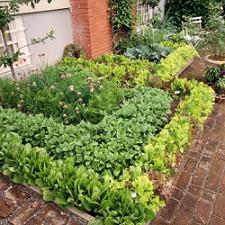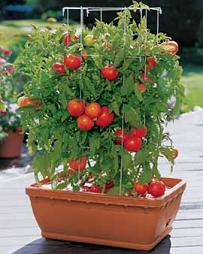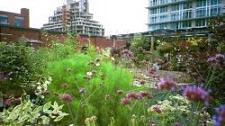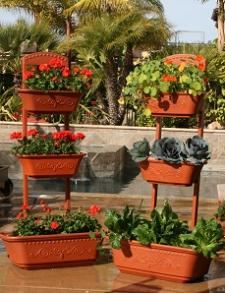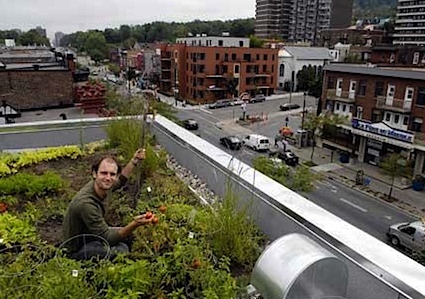Editor's Note: In times when corporate food prices are high and folks are hard pressed to make ends meet, Ellen LaConte suggests that we buy locally and grow our own! We introduce her lovely and informative article with some photos of urban gardens and their fruits to illustrate what she's teaching us!
- Les Blough, Editor
|
|
|
|
|
|
|
|
|
|
|
|
|
|
|
|
Tips from Ellen LaConte, author of Life Rules: Why so much is going wrong everywhere at once and how Life teaches us to fix it (Green Horizon, 2010, ISBN: 978-1-4502-5918-7, $21.95, www.ellenlaconte.com)
Earth Day is almost here, and there’s no better way to go green than to, well, grow green.
That’s right. Raising fruits and vegetables in your own backyard (or, for city dwellers, in containers on your own balcony) brings a bounty of benefits. Most obviously, it’s a wonderful source of fresh, delicious, wholesome food. But beyond that, gardening is also great exercise. It’s relaxing, spiritually rewarding, and deeply satisfying—especially in light of the artificial environments in which most of us live and work.
And according to Ellen LaConte, it’s a life skill we should all cultivate.
“It’s interesting to me that people work so hard to acquire the skills we need to make a living, yet most of us neglect the most basic, essential, and valuable skill of all: the ability to feed ourselves,” says LaConte. “We depend almost totally on other people to provide the nourishment that keeps us alive.”
The great news is that gardening is downright easy—even if you’ve never grown anything except mold on your store-bought cheese! Here, LaConte offers some tips sure to inspire even the most tentative “veggie virgins” to dig right in!
Don’t assume lack of space is a deal-breaker. Most of us don’t live on farms. Nor do we have spacious, magazine-worthy backyards. And in the case of city-dwellers, we may not have backyards of any type! That’s okay, says LaConte, who is something of an outside-the-box thinker when it comes to gardening in smaller or unconventional settings. (In fact, based on her own experiences, she has written articles on turning suburban outdoor spaces into “tiny homestead Edens.”)
In general, LaConte recommends that neighborhood gardening novices start with one of two easy options: the container garden or the raised-bed garden. (A quick Internet search will unearth a plethora of advice, instructions, and details about each.)
Make your bed…raised! A raised-bed garden is one that is built on top of your native soil—in other words, you don’t have to dig into your yard and can build it wherever you want. It can be enclosed by lumber, stone, brick, concrete, or even hay bales, and is filled with whatever type of soil you choose.
Advantages include (but are certainly not limited to): improved accessibility (you don’t need to stoop as far to reach your plants), good drainage, fewer weeds, the ability to plant more densely, and improved soil quality. Also, raised-bed gardens heat up more quickly than the native soil, so you’ll be able to plant sooner and you’ll probably enjoy a higher produce yield.
Contain yourself! Did you know that almost any vegetable, and quite a few fruits (such as berries, limes, and melons), can be adapted to growing in a pot? It’s true! So even if you’ve got no yard at all, you can still cultivate a container garden on your balcony, patio, or windowsill. As with a raised-bed garden, container gardens are very accessible and offer you total control over soil quality. Keep in mind a few simple guidelines such as making sure that larger plants are in larger containers and that all have adequate drainage holes, and you’re good to garden!
Start small. If you bite off more produce than you can chew, you may become overwhelmed and leave your garden to the not-so-tender mercies of nature. If you’re a newbie, choose just a few easy-to-cultivate vegetables, fruits, and herbs, preferably ones that already feature prominently in your diet. You can let yourself gradually catch the gardening bug from there!
Don’t panic: You’ll find the time. Prospective gardeners may be excited by the idea of growing their own fruits and vegetables but daunted by the scope of the project ahead of them. If you’re wondering where you’re going to find the time to cultivate and harvest plants, take a deep breath. After the initial effort of planting and potting is over, your daily garden chores such as watering and weeding will usually be done in 15 to 30 minutes. And when you consider how much time most of us waste in front of the computer or TV, well…the task ahead of you might not be so difficult to fit in after all. (And it’ll certainly be more nourishing!)
“Grow” easy on yourself. The fact is, some types of produce are much hardier and easier to grow than others. Why make your first foray into gardening more difficult than it needs to be by trying to raise plants that are needy? Start with tried-and-true plants like basil, rosemary, blueberries, tomatoes, lettuce, and peppers, for example.
It’s as easy as one, two, TREE. When most people think “gardening,” trees don’t necessarily spring to mind. While it’s true that trees can take longer than tomato plants or berry bushes to yield fruit, the wait is usually well worth it. Consider planting cherry, apple, peach, etc. saplings in your yard. As they grow, these trees will be both beautiful and practical. And the yardless needn’t be left out—remember that fruits such as peaches, plums, figs, lemons, limes, etc. (often available in dwarf varieties) can be grown in pots.
Farm alongside your flowers. Many people whose patios or yards are livened up by colorful flowers have never given a second thought to raising produce. If you’re one of them, consider this: You already have the knowledge and skills to care for plants. So why not plant some tomatoes or cilantro along with those zinnias and pansies?
Grow your own “spice rack.” Many people don’t immediately think of herbs when they hear the word “gardening,” but the truth is that these little plants are generally easy to grow, don’t require much space (think window boxes and small pots), and can really spice up your meals! Plus, with a little advance planning, you can stock your shelf with dried herbs that will last the whole year round.
Practice pollution-free pest control. If you are able to grow and harvest your produce with no unwelcome critters taking a bite or two, consider yourself lucky! The fact is, it’s a good idea to have a pesticide plan in place…but you don’t have to risk polluting your yard or harming beneficial insects in the process. For example, hot pepper sprays, garlic, used dishwater, and even some varieties of plants naturally repel insects and animals alike.
Make it a group effort… Nobody ever said that gardening had to be a solitary activity! For example, you might grab a neighbor (or two or three) and share the hoeing, weeding, and watering chores. And when your labors bear fruit, you can share that as well. (Also, it’s worth noting that gardening doesn’t have to be an adults-only activity. It can be a great bonding experience for families, too—working outside is much healthier than playing a video game or watching TV, and your kids will learn quite a bit in the process.)
…or a community-wide one! If you like the idea of enlisting aid in your cultivation efforts but don’t have the desire or space to “host” a garden yourself, research to see if there are any community gardens in your area. They may charge a fee for participation and might feature plots that are collectively gardened or plots that are allotted to individuals. One thing’s for sure, though—you’ll be able to take advantage of the expertise of your fellow gardeners, and you’ll probably make some new friends in the process!
If you need some guidance, find a 4-H club… Maybe you didn’t leave your 4-H days behind with your adolescence after all! The fact is, 4-H offers programs to its members that focus on plant science. Your local club might be able to give you personalized advice on your fledgling gardening endeavor…and you might find a fulfilling volunteering or mentoring opportunity in the process!
…or hit up the hardware store. Most hardware stores with gardening centers have everything you need to get started—and that doesn’t just include plants and gardening implements (though those are available in spades—pun intended!). Ask employees for advice on everything from which plants grow well in shade to how often to fertilize, and you’ll go home with your questions answered.
…or make friends at a farmer’s market. Chances are, there’s one near you…and who better to ask for tips and tricks than your fellow citizens who have already learned to garden successfully? This is also a good venue at which to learn about community gardens and group efforts. And bonus: You might be able to set up a booth yourself sooner than you think!
# # #
About the Author:
A memoirist, magazine and book editor, and freelance writer, Ellen LaConte has been published in numerous magazines and trade journals on subjects ranging from organic gardening and alternative technologies to the evolution of consciousness, democracy theory, and complex systems. After three decades of homesteading in Connecticut and Maine, she gardens now on a half-acre in the Yadkin River watershed of the Piedmont bioregion of North Carolina.
About the Book:
Life Rules: Why so much is going wrong everywhere at once and how Life teaches us to fix it (Green Horizon, 2010, ISBN: 978-1-4502-5918-7, $21.95, www.ellenlaconte.com) is available from major online booksellers and can be ordered by bookstores nationwide.

